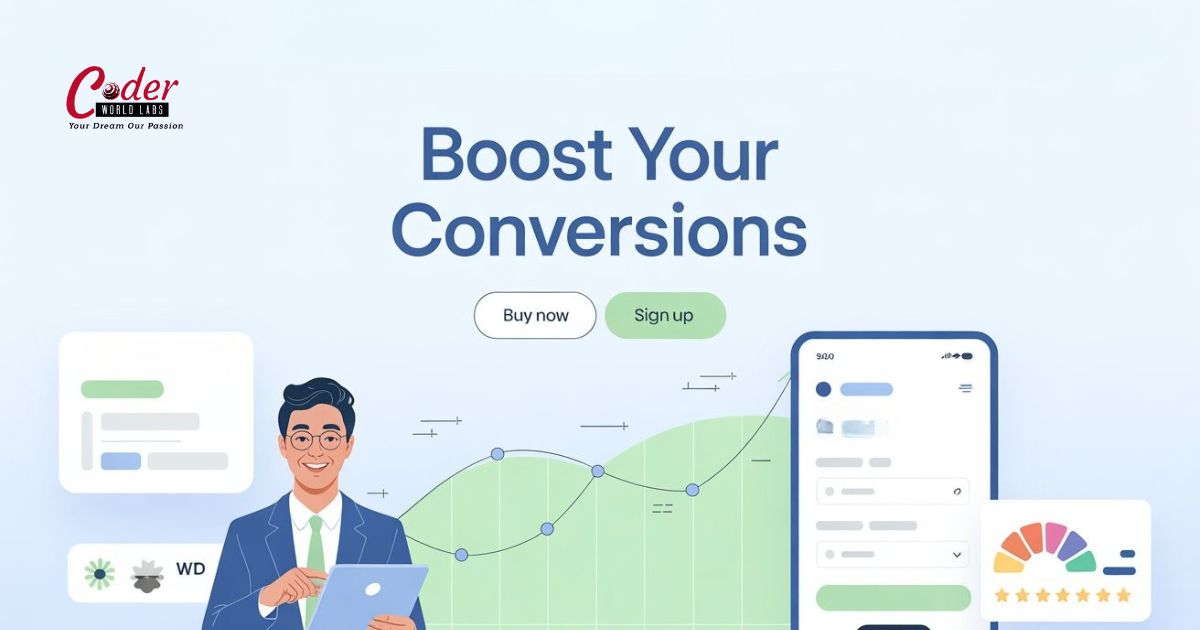
Conversion Rate Optimization (CRO) isn’t about minor design tweaks and it’s a structured approach focused on analyzing user behavior, reducing friction & driving actions that improve business goals. CRO starts by identifying user experience issues slow load times, unclear CTAs or poor mobile layouts and then, it moves into testing and iteration to improve those weak points. The aim? Help users complete actions like purchases or sign-ups with ease. CRO includes A/B testing, funnel analysis, form simplification, heatmap tracking & faster site performance, each of these steps improves how users interact with your platform.
You’re not just increasing conversions; you’re creating a better journey for your visitors and it’s a balance of UX design, technical performance & psychological triggers that make people take action. A good CRO plan can significantly increase your conversion rate without increasing your ad spend. Instead of chasing more clicks, you convert the ones you already have. Whether you’re running an eCommerce store, SaaS platform, or lead-generation site CRO helps make the most of your existing traffic. Companies that apply CRO methods consistently enjoy improved ROI, better customer satisfaction & scalable growth, done right, it’s one of the most effective ways to grow any online business.
What is Conversion Rate Optimization?
CRO (Conversion Rate Optimization) focuses on enhancing website or landing page experiences to increase the percentage of users who complete key actions. These actions can include submitting a form, signing up for a service, or finalizing a purchase and instead of simply attracting more traffic, CRO aims to make better use of existing traffic. It identifies usability issues, improves user flow & removes friction points that prevent conversions.
The process involves continuous testing and refinement based on data, ensuring users find it easier to act and with a good CRO strategy, businesses can drive more value from the same number of visitors, leading to better revenue performance without higher ad spend.
Why Focus on CRO Techniques?
Ads don’t guarantee conversions, most users leave without taking action. That’s where CRO comes in. A strong CRO strategy analyzes behavior, removes barriers & guides users to convert. It focuses on optimizing layouts, CTAs, speed & experience. The result? More sales, leads & engagement from your existing traffic and you’ll lower acquisition costs while increasing ROI. Businesses using CRO consistently outperform those that don’t. It’s smart, measurable & highly effective for long-term growth online.
- Higher ROI on existing traffic
- Lower customer acquisition cost
- Better user experience & engagement
Proven CRO Techniques to Try
- A/B Testing – Test multiple versions of a page element to compare performance, determine what drives results & continuously optimize based on accurate performance data & user behavior insights.
- User Behavior Analytics – Analyze heatmaps, scroll tracking, clicks & user session recordings to understand pain points, identify drop-offs & improve overall flow based on real engagement.
- Faster Page Speed – Improve site speed by optimizing images, minimizing JavaScript, reducing redirects & using CDN. Even one-second delays can significantly reduce conversion rates.
- Clear CTAs – Make your calls-to-action visible, action-oriented & strategically placed. Use contrast colors, strong verbs & minimal distractions to improve click-through & conversions.
- Social Proof – Display reviews, testimonials, trust badges & real-time user stats to boost credibility, reduce hesitation & encourage new visitors to take desired actions.
- Mobile Optimization – Ensure your entire experience is responsive. Optimize touch elements, improve load speed & streamline navigation to increase conversions across all mobile devices.
- Exit-Intent Popups – Use popups triggered when users move to exit. Offer discounts, free trials or content downloads to capture leads right before they leave.
- Form Optimization – Simplify forms by removing unnecessary fields, use auto-fill, progress indicators & inline validation to make submission faster & reduce abandonment.
- Live Chat & Support – Provide instant help via chatbots or agents. Address objections, answer queries in real time & guide users to convert confidently.
- Retargeting Campaigns – Reconnect with visitors who left without converting. Show personalized ads based on user actions, keeping your brand top-of-mind & encouraging return visits.
Metrics You Must Track
Tracking performance metrics is essential in any CRO strategy and it helps identify what’s working and where improvements are needed for better conversions and efficient user experience.
- Conversion Rate (%) – The percentage of visitors who complete desired actions such as purchases, sign-ups, or downloads.
- Bounce Rate – The rate at which users leave your website after viewing only one page.
- Average Session Duration – Indicates user engagement by measuring how long visitors stay on your site.
- Click-through Rate (CTR) – Measures the number of clicks on a link, ad, or CTA versus total views.
- Cart Abandonment Rate – Tracks how often users leave after adding products to their cart without completing the purchase.
Conclusion
Improving conversion rates is a systematic process based on data, testing & user behavior. Effective CRO techniques guide users toward action without increasing ad spend, from refining CTAs to simplifying forms and using behavior analytics, the goal is to remove obstacles and enhance the journey. Even small changes can lead to big improvements so Coder World Labs helps businesses implement proven CRO methods that drive consistent growth and maximize results from existing website traffic.
